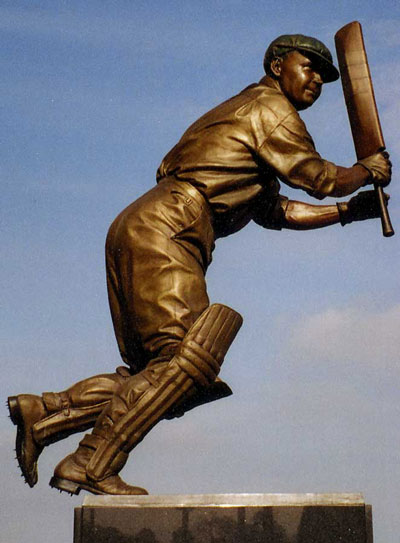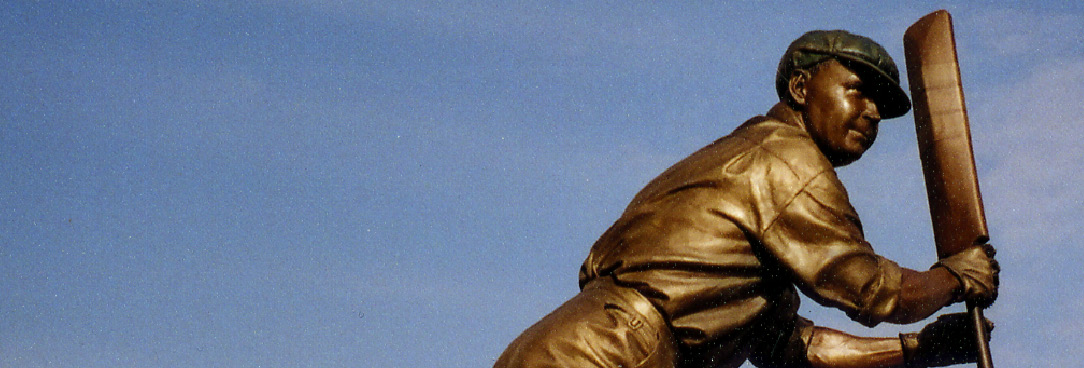Last updated:
'Researching a Cricket Book', Provenance: The Journal of Public Record Office Victoria, issue no. 5, 2006.
ISSN 1832-2522. Copyright © John Leckey.
This article presents the process of researching a book-length biography on Victorian cricketing great Bill Ponsford using primary sources. In particular, the article discusses some of the useful research pathways that are available using PROV records and other collections in preparing such a biography.
The market for cricket books is large and growing in cricket-playing countries. Many new titles are written and sold each year but there is also a continuing demand for second- hand books, of which Cricket Crisis (Cassell, London, 1946) by JH Fingleton is an example. Several specialist antiquarian bookshops service the market, which includes a substantial collectors’ component. Publishers like cricket books because of the established sales pattern, especially if the marketing of the book can be associated with an event like a test tour.
Having written a number of commissioned business biographies, I was encouraged (nagged) by a cricket fan to research and write a biography of a famous test cricketer of the 1920s and 1930s, Bill Ponsford, who was my friend’s neighbour for many years. Eventually I approached the Ponsford family, who retain quite good records, although no correspondence, and the Melbourne Cricket Club, where Ponsford worked for thirty-seven years. The result was that both parties were supportive and a former publisher was pleased to undertake the production.
Most cricket books are about matches, scores, runs and balls. Already a respected book had been written about Ponsford’s playing career (Marc Fiddian, Ponsford and Woodfull: a premier partnership, Five Mile Press, 1988). My proposal was to take the statistical details as read and write a book about Ponsford as an individual, constructed along the lines of my other biographies. This would involve research into the forebears of the family and their occupations, their migration to Australia and settlement in their new country. It would mean searching for details of their marriages, births and deaths and their housing and schooling. It would also mean researching details of Ponsford’s employers, which were in turn The State Savings Bank of Victoria, The Herald and Weekly Times and the Melbourne Cricket Club.
Little was known of the Ponsford forebears except that Bill’s father, William Ponsford, worked in the postal service in Melbourne and that his grandfather, also William, married in Bendigo, having migrated from Devon in England in 1862. As usual in family research, the first port of call was Public Record Office Victoria in North Melbourne. Using the birth, death and marriage indexes on the PROV reading room computers I tracked down the relevant dates for each generation of Ponsford forebears. This enabled me to locate the actual certificates of birth, death and marriage online at the Registry of Births, Deaths and Marriages website (which can be accessed through http://online.justice.vic.gov.au/servlet/bdm-home) and to print out my own copies at home. As a result I gained very valuable information on parentage, causes of death, places of origin, spouses, and names and ages of children. From the shipping records at PROV I found the vessel on which the first Ponsford arrived in Australia, the size of the ship, its captain, the length of the voyage and the names and occupations of Ponsford’s fellow passengers, most of whom were optimistic miners on their way to the goldfields in central Victoria. Further details of the Ponsford individuals were gained from the City of Melbourne Citizen Lists and/or Citizen Rolls (VPRS 4029) and Rate Books (VPRS 5708), which revealed information on residential dimensions, rates paid and names of neighbours. Wills and probate records found in VPRS 7591 and VPRS 28 respectively provided data on real property and personal assets and names of executors. The well-selected collection of reference books and history classics in the PROV North Melbourne reading room was also helpful. In my case, Henry Gyles Turner’s The history of the colony of Victoria (Longman’s, London, 1904) and Geoffrey Serle’s The rush to be rich: a history of the colony of Victoria, 1883-1889 (Melbourne University Press, 1971) provided useful background material about the goldrush period.
Adding to the PROV information were the important Sands and McDougall postal directories, located at the Baillieu Library and elsewhere. That careful detective work has to be followed is illustrated by the Ponsford study. Several William Ponsfords appeared in the directories between 1874 and 1900, including a most promising entry for the years 1886 to 1894 – a postmaster at Heidelberg Road, Alphington. Cognisant that Bill’s father worked in the postal service and aware that sons tended to follow in their fathers’ trades, it seemed likely that I had located the residence of Bill’s grandfather, or at least his great- uncle. Other Ponsfords appeared in the directory as butcher, grocer and van man (carrier). From the rate books and death and probate records at PROV, however, it turned out that the postmaster hailed from Essex rather than Devon and that his descendants were unrelated to our Ponsfords. It also transpired that the van proprietor was Bill’s grandfather, who had invested in a carrying business running between the goldfields at Bendigo and Carlton North. Previously, he had spent over twenty years working underground in the quartz gold mines. His family had arrived in Melbourne in 1888, the peak year of the land boom and had purchased one of the thousands of boom-period terrace houses erected for workers’ families. The draft horse was stabled at the rear of the property. The van proprietor secured his son William (Bill’s father) a steady job at fourteen by having him employed as a telegraph delivery boy at the Carlton post office at a wage of £2 per month. This is the equivalent of $199 in 2004 values (the latest available).
Tracing William’s postal career was more straightforward than I expected when Australia Post’s historian advised that the positions and salaries of all postal employees (and other public servants) were published every year in the Commonwealth Government Gazette. Worthwhile details of the workings of the early postal service were found in the reports of a royal commission of 1908-10, published in the Commonwealth Parliamentary papers. From telegraph boy, William progressed steadily through the service to letter carrier (postman), porter, letter sorter and supervisor of letter carriers.
Researching the employment records of the next generation should have been more straightforward. But Bill Ponsford’s career provides a good example of the frustrations an historian can encounter. Having passed his banker’s exams at the age of fifteen, young Bill joined the State Savings Bank of Victoria as an office boy in 1916. He enjoyed his ten years with the bank and the bank was very proud of their record-breaking clerk, presenting him with a gold watch and chain when he established a new world-record batting score of 429 in 1922-23. Bill left the bank in 1927 when, turning down a lucrative offer from an English cricket club, he was ‘saved’ for Australian cricket by a journalistic position on the Herald. Seeking his employment records, I found that when the bank (then named the State Bank of Victoria) collapsed in the 1980s and was absorbed into the Commonwealth Bank in 1991, the old records were supposed ultimately to have been passed over to PROV. Some old employment records are in PROV custody, but unfortunately, the Ponsford details are not among them.

Photograph courtesy of John Leckey.
Bill became a valuable journalist for the Herald and the public throughout Australia read his columns with pleasure, especially as at the same time he was continuing to make big scores in first-class cricket. During important matches Bill would telephone his special comments back to the paper during breaks for lunch and tea. Quite often he was headline news himself and his achievements were reported on the front page, no doubt helping to boost newspaper sales. A prime example occurred in the 1928 test at Brisbane, when the fearsome English fast bowler, Harold Larwood, broke Ponsford’s little finger with a particularly fast delivery. King George V was ailing seriously at the time but Ponsford’s little finger brought the banner headlines, above news of the king’s condition. Next day, an X-ray photograph of the finger appeared on the top of the front page!
When I approached the Herald and Weekly Times about its 1920s employment records, I found that the company had discarded them. However, through assiduous reading through years of old Heralds on microfilm at the State Library of Victoria, I was able to reconstruct the history of Bill’s five years of employment (1926-31) because the newspaper gave plenty of publicity to their young star recruit.
Despite this, Bill did not really enjoy being a journalist. When his contract expired in 1932, he resisted the personal entreaties of the head of the Herald, Keith Murdoch (later Sir Keith), and joined the Melbourne Cricket Club in the office under Secretary Hugh Trumble. His main duties included administering the vast club membership, arranging cricket practice and matches for the members, and managing the casual workers who manned the turnstiles and gates on test and football match days at the Melbourne Cricket Ground. He retired from the job in 1969. In recognition of his service to the MCC and cricket, the Ponsford stand was named in his honour. The MCC’s employment records are apparently quite sound, but again there is a catch. During the demolition of the old members’ stand and its replacement in time for the Commonwealth Games in 2006, the archives were boxed up and packed away in a warehouse and will not be available for many months.
Material in the Public Record Office Victoria archival collection contains words and descriptions that reflect attitudes and government policies at different times which may be insensitive and upsetting
Aboriginal and Torres Strait Islander Peoples should be aware the collection and website may contain images, voices and names of deceased persons.
PROV provides advice to researchers wishing to access, publish or re-use records about Aboriginal Peoples
